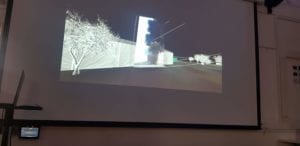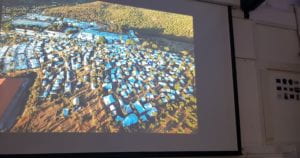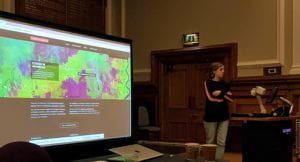The LLB Law at Goldsmiths is innovative and cutting edge, preparing lawyers for a flexible 21stcentury workplace. As such, the programme places a strong emphasis on inter-disciplinary legal analysis and equipping students with skills that are applicable to the legal profession as traditionally conceived (see, for example, our recent announcement about integrating workshops and advice on the barrister profession by the Honourable Society of the Inner Temple) but also honing skills that will be central to future legal careers.
The latest illustration of this modern approach to legal studies is an emerging collaboration with Forensic Architecture, the pioneering research agency that undertakes advanced architectural and media research on behalf of international prosecutors, human rights organisations and environmental justice groups.
On 25 March 2019, Head of Goldsmiths Law, Prof Dimitrios Giannoulopoulos, visited the award winning agency, where MA students in Research Architecture were presenting their ongoing forensic investigations, under the supervision of Dr Lorenzo Pezzani (who leads the MA Studio in Forensic Architecture) and in the presence of the director of the agency, Eyal Weizman.
The MA in Forensic Architecture examines how architecture can engage with questions of contemporary culture, politics, media, ecology and justice. Goldsmiths Law is very keen to collaborate with the MA in relation to research and teaching at the intersection of architecture and justice.
One of the students who presented their work at the workshop, Dimitra Andritsou, examines the politics of fire at play at Moria refugee camp on the island of Lesvos, one of the frontier ‘chokepoints’ of the European border regime.

Slide from Dimitra Andritsou’s research presentation on fires at the Moria refugee camp as a manifestation of abandonment from the part of the state (credit: Dimitra Andritsou)
‘From blazes of indignation to flaring humanitarian infrastructure, fire on the island emerges as a lurking, ubiquitous presence’, her research project argues.
Dimitra’s work interrogates fire’s ‘manifestation as an ambiguous force that highlights the precarious, differentiated regime of abandonment and care, and thus signals institutional failure at diverse, inter-scalar registers’.

The Moria refugee camp (copyright: Giorgos Moutafis/Reuters)
Entering in conversation with Prof Giannoulopoulos about varied levels of accountability, and opportunities for intervention, from the local to the national and then to the transnational, including from relevant EU institutions, Dimitra replied that there was ‘an urgent need to problematize and rethink how accountability may be addressed at diverse levels in such a conflictual field’.
Earlier on this academic year, Forensic Architecture’s deputy director, Christina Varvia, spoke at Goldsmiths Law’s symposium on Technology and Human Rights (November 2018).

Forensic Architecture’s deputy director, Christina Varvia, speaking at Goldsmiths Law’s symposium on technology and human rights
Forensic Architecture have won several awards for their bold and innovative work, and were nominated for the 2018 Turner Prize.